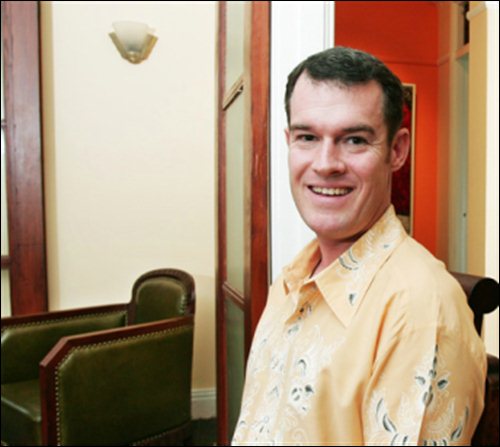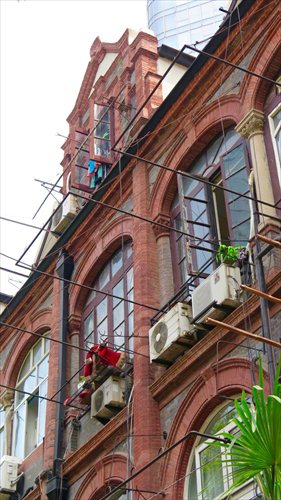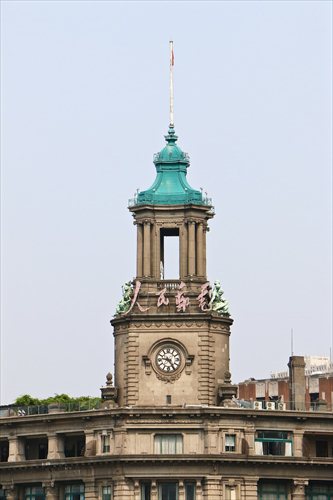Stepping back through time
Co-author Spencer Dodington revisits old Hongkou via buildings, its people
When the news came out last year that Tess Johnston, author of 15 volumes on the history of Shanghai and a longtime American resident of Shanghai at 35 years, was going to leave the city this April, designer Spencer Dodington (pictured below) and four other expats wanted to honor her time.
The plan was get Johnston to contribute to one more book on Shanghai's historical architecture with them. After about a year, The Where's Where of the Who's Who of Old Shanghai came out this month.
All the authors love Shanghai history and walking around the city, and they know the city from ground up.
They divided different former concession neighborhoods among themselves, and wrote their book in a way that could be used as a tool for self-guided tours around the area. It also includes the biographies of 37 people who lived in Shanghai before 1949.
Dodington picked the lesser-known Hongkou.
Last week the Global Times spoke with Dodington, who moved from Texas to Shanghai in 1995 and became an architect after studying at Tongji University. Occasionally, he dropped fluent Shanghainese.

GT: Why did you pick Hongkou?
SD: Hongkou still has the 1990s Shanghai flavor. It's not like Xintiandi; it's not posh; it's not redone and urbanized and moneyed-up.
When I got here, Fuxing Road and Huaihai Road felt like Hong-
kou. Hongkou still has some "real Shanghai" - more real for me than Xintiandi.
GT: The focus is on the personalities behind the architecture, and you searched for relatively unknown people. What kind of materials did you use?
SD: Every author has his own favorite resources. Hongkou really is the lesser-known part, so there wasn't much information in English-language newspapers or telephone directories.
But what I found was some interesting articles in Japanese history books - I speak and read Japanese - and novels written by English people who used to live in Shanghai. I used that to find out who were the interesting people, and I researched the people's names wherever I could.
So that's different resources than the other authors. I think a lot of the authors, particularly in the former French concession, could use either neighborhood hearsay or newspapers from the old days, like the North China Daily Herald.

Spencer Dodington picks the lesser-known Hongkou as his focus in the new book The Where's Where of the Who's Who of Old Shanghai. Photos: Courtesy of the author
GT: You also photograph and sketch Shanghai's architecture. Do they appear in the book too?
SD: Unfortunately, no. I didn't even think of that. I used something I collected over the years, like a photograph of the spoon from the New Asia Hotel, instead to show unique characteristics of a building, rather than the photo of a building.
Photos of buildings are common; I try to look at different things. But next time, sketching! (laughs)
GT: What was the most difficult part of writing this book?
SD: Limiting the walks. We tried to keep every walk within two hours. But you want to see so many interesting things, you are going all around, you want to do a little bit of everything. We want to have a varied attitude, so among the 37 people, there are 12 Chinese, 12 English, 10 American, women, men … We try to have diversity.
We could do even more diversity next time. Like, we didn't do Japanese or Russian people.

GT: Which three buildings in Hongkou do you like the best?
SD: Definitely 1933 Shanghai is one. But everyone loves 1933; I should give you buildings that nobody knows and your readers would have to go and investigate.
Kunshan Park is beautiful. It is the Xintiandi kind of old-brick-new-brick, but it is all original. It is a Queen Anne revival architecture, which was a very popular architecture style about 120 years ago in England and then brought over to Shanghai.
The old General Post Office (pictured above) on Sichuan Road North is really cool. It is really well-preserved and restored nicely by the government. And it's got a museum, got a roof terrace. It is one of the fun places to visit in Shanghai, because you get a nice view from there.
Last one is the Japanese Buddhist Temple on Zhapu Road. It is so different from a Chinese-style temple; it looks very Indian. It is a completely unique structure for Shanghai.
I would have thought after World War II, all Japanese architecture might have been destroyed, but this is still there. Right now it functions as a nightclub; it's incredible.
GT: There are quite a number of books about Shanghai's former concession architecture. How does your writing bring something new?
SD: We focus not only on people that are less-known, but also on the buildings that are less-known.
I really like looking for new ones, and figuring out what the history was. I found a Japanese school that was built in 1929 - it was first for everyone, and then only Japanese, and then only Chinese in Hongkou, and then it became a government building.
Buildings are magical because they usually last longer than the people who built them. They have a longer life, and they live through wars and revolutions, and they have all the stories to tell.